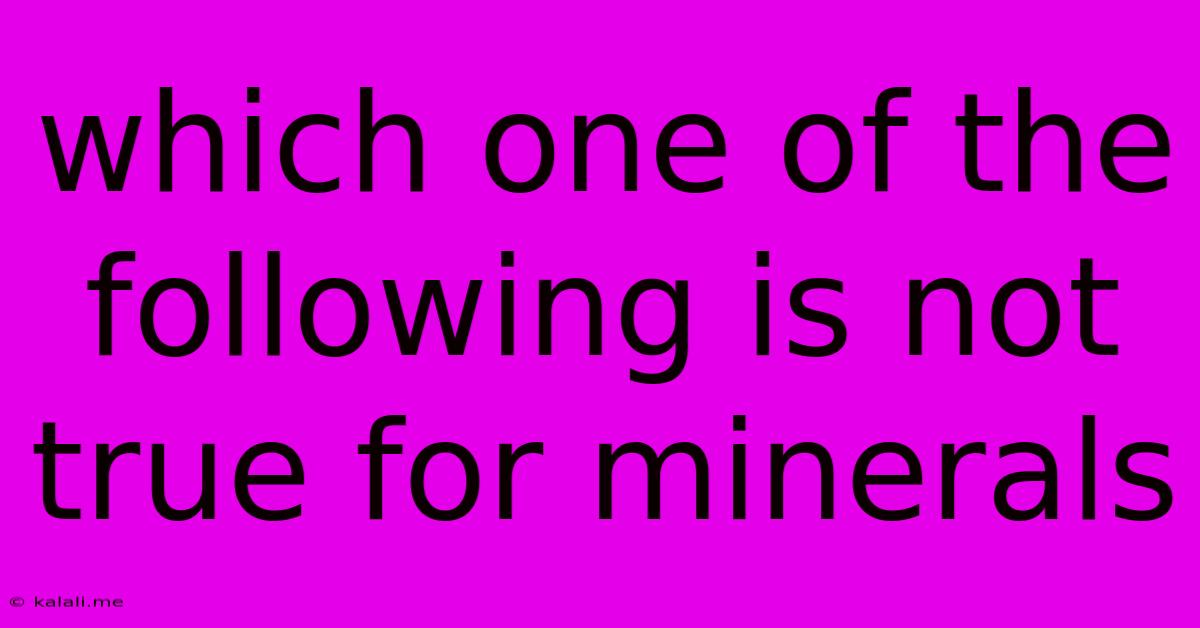Which One Of The Following Is Not True For Minerals
Kalali
Jun 12, 2025 · 3 min read

Table of Contents
Which One of the Following is Not True for Minerals? A Deep Dive into Mineral Properties
Minerals are the building blocks of rocks, the foundation of our planet, and essential components in countless industrial processes. Understanding their defining characteristics is crucial in geology, materials science, and even everyday life. This article explores the fundamental properties of minerals and clarifies which statement among common misconceptions is not true. We'll delve into the details, separating fact from fiction to solidify your understanding of these fascinating natural substances.
What Defines a Mineral?
Before we can identify the false statement, let's establish the key characteristics that define a mineral:
- Naturally Occurring: Minerals are formed by natural geological processes, not synthesized in a lab.
- Inorganic: They are not produced by living organisms or their remains.
- Solid: Minerals exist in a solid state at standard temperature and pressure.
- Crystalline Structure: Their atoms are arranged in a highly ordered, repeating three-dimensional pattern. This internal arrangement dictates their physical properties.
- Definite Chemical Composition: While some variation is possible, minerals have a specific chemical formula representing their constituent elements.
Common Misconceptions about Minerals: Debunking the Myths
Now, let's address the frequently encountered statements about minerals that are often mistaken for truth:
Misconception 1: All Minerals are Crystalline
While most minerals exhibit a crystalline structure, some minerals, particularly those formed under rapid cooling conditions, might appear amorphous (lacking a regular structure) to the naked eye. However, at a microscopic level, even these amorphous minerals will exhibit some degree of short-range order in their atomic arrangement. This is crucial to understanding the fundamental nature of minerals.
Misconception 2: Minerals are Always Homogenous
While minerals possess a definite chemical composition, they might contain minor impurities or variations in their structure. This can lead to subtle differences in color, transparency, or other physical properties within the same mineral sample. The overall composition and crystal structure remain consistent enough to classify the material as a specific mineral.
Misconception 3: All Minerals are Hard
The hardness of a mineral is defined by its resistance to scratching, usually measured using the Mohs Hardness Scale. While some minerals like diamond are exceptionally hard, others are quite soft, like talc. Hardness is a property specific to the mineral's chemical structure and bonding. Therefore, declaring all minerals as hard is incorrect.
Misconception 4: All Minerals are Valuable
While some minerals are valuable gemstones or have significant economic importance (e.g., ores containing metals), many are abundant and commonplace. Economic value is determined by market forces and the mineral's rarity, properties, and usefulness, not an inherent property of the mineral itself.
Misconception 5: Minerals Cannot be Organic
This is definitively false. Minerals must be inorganic. The presence of organic compounds would exclude a substance from being classified as a true mineral.
Conclusion: Identifying the False Statement
Based on the definitive characteristics of minerals, the statement that is not true is that all minerals are valuable. Value is an economic attribute, not a geological one. Minerals are defined by their natural occurrence, inorganic nature, solid state, crystalline structure, and definite chemical composition. Understanding these characteristics helps us appreciate the diversity and importance of minerals in our world.
Latest Posts
Latest Posts
-
Which Of The Following Is A Qualitative Research Method
Jun 13, 2025
-
How To Spell 20 In Word Form
Jun 13, 2025
-
Crossing Over Takes Place During Which Phase Of Meiosis
Jun 13, 2025
-
What Is One Example Of A Closed Economy
Jun 13, 2025
-
Range That Separates Europe And Asia
Jun 13, 2025
Related Post
Thank you for visiting our website which covers about Which One Of The Following Is Not True For Minerals . We hope the information provided has been useful to you. Feel free to contact us if you have any questions or need further assistance. See you next time and don't miss to bookmark.